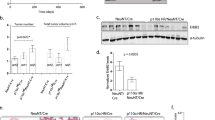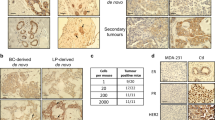Abstract
We investigated the role of protein tyrosine phosphatase 1B (PTP1B) in mammary tumorigenesis using both genetic and pharmacological approaches. It has been previously shown that transgenic mice with a deletion mutation in the region of Erbb2 encoding its extracellular domain (referred to as NDL2 mice, for 'Neu deletion in extracellular domain 2') develop mammary tumors that progress to lung metastasis. However, deletion of PTP1B activity in the NDL2 transgenic mice either by breeding with Ptpn1-deficient mice or by treatment with a specific PTP1B inhibitor results in significant mammary tumor latency and resistance to lung metastasis. In contrast, specific overexpression of PTP1B in the mammary gland leads to spontaneous breast cancer development. The regulation of ErbB2-induced mammary tumorigenesis by PTB1B occurs through the attenuation of both the MAP kinase (MAPK) and Akt pathways. This report provides a rationale for the development of PTP1B as a new therapeutic target in breast cancer.
This is a preview of subscription content, access via your institution
Access options
Subscribe to this journal
Receive 12 print issues and online access
$209.00 per year
only $17.42 per issue
Buy this article
- Purchase on Springer Link
- Instant access to full article PDF
Prices may be subject to local taxes which are calculated during checkout








Similar content being viewed by others
Accession codes
References
Baselga, J. & Norton, L. Focus on breast cancer. Cancer Cell 1, 319–322 (2002).
Slamon, D.J. et al. Studies of the HER-2/neu proto-oncogene in human breast and ovarian cancer. Science 244, 707–712 (1989).
Hutchinson, J.N. & Muller, W.J. Transgenic mouse models of human breast cancer. Oncogene 19, 6130–6137 (2000).
Bargmann, C.I., Hung, M.C. & Weinberg, R.A. Multiple independent activations of the neu oncogene by a point mutation altering the transmembrane domain of p185. Cell 45, 649–657 (1986).
Bargmann, C.I. & Weinberg, R.A. Oncogenic activation of the neu-encoded receptor protein by point mutation and deletion. EMBO J. 7, 2043–2052 (1988).
Siegel, P.M., Dankort, D.L., Hardy, W.R. & Muller, W.J. Novel activating mutations in the neu proto-oncogene involved in induction of mammary tumors. Mol. Cell. Biol. 14, 7068–7077 (1994).
Siegel, P.M., Ryan, E.D., Cardiff, R.D. & Muller, W.J. Elevated expression of activated forms of Neu/ErbB-2 and ErbB-3 are involved in the induction of mammary tumors in transgenic mice: implications for human breast cancer. EMBO J. 18, 2149–2164 (1999).
Citri, A., Skaria, K.B. & Yarden, Y. The deaf and the dumb: the biology of ErbB-2 and ErbB-3. Exp. Cell Res. 284, 54–65 (2003).
Perez-Nadales, E. & Lloyd, A.C. Essential function for ErbB3 in breast cancer proliferation. Breast Cancer Res. 6, 137–139 (2004).
Kwong, K.Y. & Hung, M.C. A novel splice variant of HER2 with increased transformation activity. Mol. Carcinog. 23, 62–68 (1998).
Andrechek, E.R. et al. Gene expression profiling of neu-induced mammary tumors from transgenic mice reveals genetic and morphological similarities to ErbB2-expressing human breast cancers. Cancer Res. 63, 4920–4926 (2003).
Zhai, Y.F. et al. Increased expression of specific protein tyrosine phosphatases in human breast epithelial cells neoplastically transformed by the neu oncogene. Cancer Res. 53, 2272–2278 (1993).
Wiener, J.R. et al. Overexpression of the tyrosine phosphatase PTP1B is associated with human ovarian carcinomas. Am. J. Obstet. Gynecol. 170, 1177–1183 (1994).
Ostman, A. & Bohmer, F.D. Regulation of receptor tyrosine kinase signaling by protein tyrosine phosphatases. Trends Cell Biol. 11, 258–266 (2001).
Bourdeau, A., Dube, N. & Tremblay, M.L. Cytoplasmic protein tyrosine phosphatases, regulation and function: the roles of PTP1B and TC-PTP. Curr. Opin. Cell Biol. 17, 203–209 (2005).
Dube, N. & Tremblay, M.L. Beyond the metabolic function of PTP1B. Cell Cycle 3, 550–553 (2004).
Dube, N. et al. Genetic ablation of protein tyrosine phosphatase 1B accelerates lymphomagenesis of p53 null mice through the regulation of B cell development. Cancer Res. 65, 10088–10095 (2005).
Dube, N., Cheng, A. & Tremblay, M.L. The role of protein tyrosine phosphatase 1B in Ras signaling. Proc. Natl. Acad. Sci. USA 101, 1834–1839 (2004).
Summy, J.M. & Gallick, G.E. Src family kinases in tumor progression and metastasis. Cancer Metastasis Rev. 22, 337–358 (2003).
Bjorge, J.D., Pang, A. & Fujita, D.J. Identification of protein-tyrosine phosphatase 1B as the major tyrosine phosphatase activity capable of dephosphorylating and activating c-Src in several human breast cancer cell lines. J. Biol. Chem. 275, 41439–41446 (2000).
Brown-Shimer, S., Johnson, K.A., Hill, D.E. & Bruskin, A.M. Effect of protein tyrosine phosphatase 1B expression on transformation by the human neu oncogene. Cancer Res. 52, 478–482 (1992).
Liu, F., Sells, M.A. & Chernoff, J. Transformation suppression by protein tyrosine phosphatase 1B requires a functional SH3 ligand. Mol. Cell. Biol. 18, 250–259 (1998).
Kaminski, R. et al. Role of SRC kinases in Neu-induced tumorigenesis: challenging the paradigm using Csk homologous kinase transgenic mice. Cancer Res. 66, 5757–5762 (2006).
Zhao, M., Janas, J.A., Niki, M., Pandolfi, P.P. & Van Aelst, L. Dok-1 independently attenuates Ras/mitogen-activated protein kinase and Src/c-myc pathways to inhibit platelet-derived growth factor-induced mitogenesis. Mol. Cell. Biol. 26, 2479–2489 (2006).
Tamir, I. et al. The RasGAP-binding protein p62dok is a mediator of inhibitory FcgammaRIIB signals in B cells. Immunity 12, 347–358 (2000).
Bellacosa, A., Kumar, C.C., Di Cristofano, A. & Testa, J.R. Activation of AKT kinases in cancer: implications for therapeutic targeting. Adv. Cancer Res. 94, 29–86 (2005).
Neve, R.M. et al. Effects of oncogenic ErbB2 on G1 cell cycle regulators in breast tumour cells. Oncogene 19, 1647–1656 (2000).
Lane, H.A. et al. ErbB2 potentiates breast tumor proliferation through modulation of p27(Kip1)-Cdk2 complex formation: receptor overexpression does not determine growth dependency. Mol. Cell. Biol. 20, 3210–3223 (2000).
Lee, R.J. et al. Cyclin D1 is required for transformation by activated Neu and is induced through an E2F-dependent signaling pathway. Mol. Cell. Biol. 20, 672–683 (2000).
Muraoka, R.S. et al. ErbB2/Neu-induced, cyclin D1-dependent transformation is accelerated in p27-haploinsufficient mammary epithelial cells but impaired in p27-null cells. Mol. Cell. Biol. 22, 2204–2219 (2002).
Yu, Q., Geng, Y. & Sicinski, P. Specific protection against breast cancers by cyclin D1 ablation. Nature 411, 1017–1021 (2001).
Altomare, D.A. & Testa, J.R. Perturbations of the AKT signaling pathway in human cancer. Oncogene 24, 7455–7464 (2005).
Montalibet, J. et al. Residues distant from the active site influence protein-tyrosine phosphatase 1B inhibitor binding. J. Biol. Chem. 281, 5258–5266 (2006).
Freiss, G. & Vignon, F. Protein tyrosine phosphatases and breast cancer. Crit. Rev. Oncol. Hematol. 52, 9–17 (2004).
Elchebly, M. et al. Increased insulin sensitivity and obesity resistance in mice lacking the protein tyrosine phosphatase-1B gene. Science 283, 1544–1548 (1999).
Liu, H. et al. Mechanism of Akt1 inhibition of breast cancer cell invasion reveals a protumorigenic role for TSC2. Proc. Natl. Acad. Sci. USA 103, 4134–4139 (2006).
Rowland, B.D., Bernards, R. & Peeper, D.S. The KLF4 tumour suppressor is a transcriptional repressor of p53 that acts as a context-dependent oncogene. Nat. Cell Biol. 7, 1074–1082 (2005).
Cheng, A., Bal, G.S., Kennedy, B.P. & Tremblay, M.L. Attenuation of adhesion-dependent signaling and cell spreading in transformed fibroblasts lacking protein tyrosine phosphatase-1B. J. Biol. Chem. 276, 25848–25855 (2001).
Jones, R.B., Gordus, A., Krall, J.A. & MacBeath, G. A quantitative protein interaction network for the ErbB receptors using protein microarrays. Nature 439, 168–174 (2006).
Lenferink, A.E., Busse, D., Flanagan, W.M., Yakes, F.M. & Arteaga, C.L. ErbB2/neu kinase modulates cellular p27(Kip1) and cyclin D1 through multiple signaling pathways. Cancer Res. 61, 6583–6591 (2001).
Landis, M.W., Pawlyk, B.S., Li, T., Sicinski, P. & Hinds, P.W. Cyclin D1-dependent kinase activity in murine development and mammary tumorigenesis. Cancer Cell 9, 13–22 (2006).
Lin, H.J., Hsieh, F.C., Song, H. & Lin, J. Elevated phosphorylation and activation of PDK-1/AKT pathway in human breast cancer. Br. J. Cancer 93, 1372–1381 (2005).
Normanno, N., Bianco, C., De Luca, A., Maiello, M.R. & Salomon, D.S. Target-based agents against ErbB receptors and their ligands: a novel approach to cancer treatment. Endocr. Relat. Cancer 10, 1–21 (2003).
Slamon, D.J. The FUTURE of ErbB-1 and ErbB-2 pathway inhibition in breast cancer: targeting multiple receptors. Oncologist 9(Suppl.), 1–3 (2004).
Acknowledgements
We thank N. Sonenberg and S. Hardy for discussions during the course of this work. We are grateful to N. Uetani and M. Narlis from the McGill Cancer Centre Developmental Histology Facility for histological and immunohistochemical protocols and helpful advice. We acknowledge the Merck Frosst Canada medicinal chemists for the gift of the inhibitor compound used in this study. N.D. is a recipient of a Canadian Institutes of Health Research doctoral award and an Alexander McFee Memorial Fellowship. W.J.M. holds a Canada Research Chair in Molecular Oncology. M.L.T. is a Chercheur National of the Fonds de Recherche en Santé du Québec. This work was supported by a Canadian Institutes of Health Research operating grant (MOP-62887) and the Jeanne and Jean-Louis Chair in Cancer Research (M.L.T.).
Author information
Authors and Affiliations
Contributions
S.G.J. performed the research, analyzed the data and wrote the manuscript. Backcrossing was performed by M.R. and J.P. Histopathology analysis was done by M.P. PTP1B inhibitor was synthesized by Y.H. and B.P.K. W.J.W. generated the ErbB2 transgenic mice. This study was designed and coordinated by S.G.J. and M.L.T. N.D. and B.P.K. contributed critical comments on the manuscript.
Corresponding author
Ethics declarations
Competing interests
The authors declare no competing financial interests.
Supplementary information
Supplementary Fig. 1
PTP1B deficiency impairs tumorigenesis in NDL2 mice. (PDF 462 kb)
Supplementary Fig. 2
Unaltered Src phosphorylation during mammary tumor progression in NDL2-ptpn1 null mice. (PDF 106 kb)
Supplementary Fig. 3
Administration of PTP1B inhibitor in NDL2-ptpn1+/+ normalizes glucose level. (PDF 49 kb)
Supplementary Table 1
Summary of phenotypic abnormalities in MMTV-PTP1B transgenic mice. (PDF 56 kb)
Rights and permissions
About this article
Cite this article
Julien, S., Dubé, N., Read, M. et al. Protein tyrosine phosphatase 1B deficiency or inhibition delays ErbB2-induced mammary tumorigenesis and protects from lung metastasis. Nat Genet 39, 338–346 (2007). https://doi.org/10.1038/ng1963
Received:
Accepted:
Published:
Issue Date:
DOI: https://doi.org/10.1038/ng1963
This article is cited by
-
A small molecule inhibitor of PTP1B and PTPN2 enhances T cell anti-tumor immunity
Nature Communications (2023)
-
Schnurri-3 drives tumor growth and invasion in cancer cells expressing interleukin-13 receptor alpha 2
Cell Death & Disease (2023)
-
Physiological expression of PI3K H1047R mutation reveals its anti-metastatic potential in ErbB2-driven breast cancer
Oncogene (2022)
-
Decoding Insulin-Like Growth Factor Signaling Pathway From a Non-coding RNAs Perspective: A Step Towards Precision Oncology in Breast Cancer
Journal of Mammary Gland Biology and Neoplasia (2022)
-
Fungal metabolites as anti-diabetic agents: emphasis on PTP1B inhibitors
Phytochemistry Reviews (2021)



